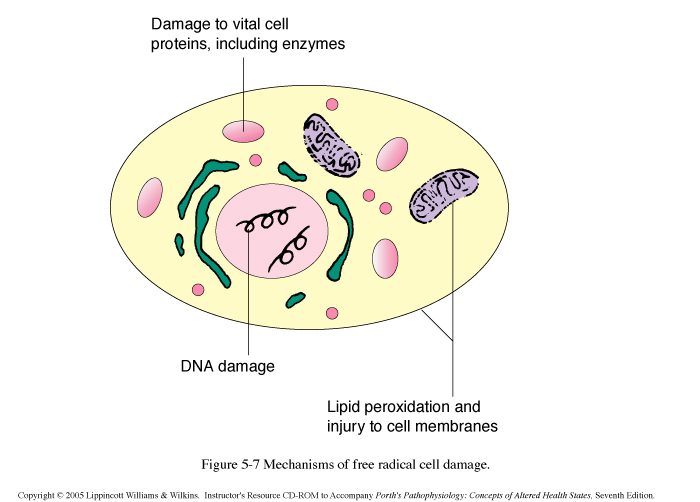|
|
 |
|

|
| In recent decades, free radicals, highly reactive and thereby destructive molecules, have come to be understood increasingly for their importance in causing disease, including cancer, and aging. Molecules are made up of atomic nuclei surrounded by orbiting electrons, paired with another electron spinning in the opposite direction. The paired electrons keep the molecule relatively stable (at a lower energy state) and hence less reactive. When one or more electrons is/are unpaired, the molecule becomes relatively unstable (at a higher energy state) and consequently more reactive with other molecules. A free radical is a molecule with one or more unpaired electrons in its outer orbital. Many of these molecular species are oxygen centred. These highly unstable molecules tend to react rapidly with adjacent molecules, often generating additional free radicals or other reactive oxygen species (ROS), which can perpetuate destructive molecular chain reactions. Because many of the components of the living cell are particularly susceptible to free radical injury, these molecular chain reactions can have substantial effects on the structure and function of living tissue. Several intracellular free radical scavenging defence mechanisms have evolved in living things to control the potentially destructive reactivity of ROS, including anti-oxidative enzymes and vitamins.
Free radicals are created in the body from a number of causes, especially radiation (including sunlight) and the uncontrolled oxidation of lipids. These radicals readily attach themselves to other molecules of the body—to the long, fibrous structures of protein, to cell membranes and organelles, and to the DNA and RNA within the cells. Whatever free radicals link with, they alter, both structurally and functionally. One of the most important aspects of disease in general and aging in particular is the accumulation of molecular injuries that are mediated by free radicals and other ROS. Specifically, structural lipids (fats) are the primary component of our cell membranes and since the integrity of these lipids defines cell viability, aging is partially a matter of our cells becoming rancid as our lipids are progressively oxidised. Gaia’s optimal anti-aging strategy is to encourage the regular use of its ultra-high antioxidant green tea along with a fruit-rich diet and the avoidance of topical substances susceptible to oxidation, in particular, skin and mucous membrane (oral) personal care products. It is a disturbing fact that most personal care body products, both completely natural as well as synthetic chemical, are potent sources of free radicals.
Gaia Research’s scientific approach to the problem of topically generated free radicals and other reactive oxygen species is to minimise sources thereof in its personal care products. It may come as a surprise, even to manufacturers of so-called “natural products” to learn that these are likely to be far more hazardous than synthetic chemical products. Fortunately there is the safer alternative (Gaia) middle way. Essentially, lipids and other natural substances that are removed from their stable intact environment in nature, become highly to susceptible to oxidation on exposure to the 21% of oxygen in the air around us, especially if also exposed to the sunlight around us, as well as environmental pollution and the warmth of our bodies. Vulnerable substances not quickly (15 minutes) assimilated into our skin, fall prey to ROS. Not only do most natural substances
quickly decompose on the skin, some, in particular plant oils
and vitamin antioxidants, progressively exhibit reverse functions,
within as little as 15-20 minutes, as active oxidation donors
and pro-oxidants. More anti-oxidants is therefore not necessarily
the ideal response to oxidation, since clearly avoidance of the
unnecessary oxidising substrate is far more intelligent means
of avoiding oxygen radical damage to the underlying strata. It
is for this reason that Gaia Research formulates only carefully
established maximum assimilable quantities of such substances,
including most plant oils, vitamins and other cellularly valuable
substances as can be safely utilised by the skin within this short
window period. Please see our report “Mineral vs Plant Oils”
for a more critical information. |
||
 |
| |
||
|
||
| |
||
|
Gaia is copyright © 2006 Gaia all rights
reserved Designed by Webs The Way |
||
|
Page Counter as of January 2008 |


